It is well known that coevolution between flowers and insects has occurred very generally. The extremes of range in shape and color of modem angiosperm flowers is known. The petals of flowers commonly show differential color makings at their base. Some of them are frequently invisible to man. Consisting of UV (ultraviolet) absorbing spots, they are discernible only to insects, such as honey bees and bumblebees, whose visual sensitivity extends into the near-ultraviolet region of the solar spectrum (Ziegenspeck, 1955; Daumer, 1958; Eisner et al., 1969). Such UV absorbing petal zones are known as nectar guides and are widely present in angiosperms (Richtmyer, 1923; Lutz, 1924; Lotmar, 1933; Daumer, 1958; Mazokhin-Porshnyakov, 1959; Kugler, 1963; Kevan, 1972; Mulligan and Kevan, 1973; Utech and Kawano, 1975). This UV patterning in petals of Potentilla was reported by previous authors (Lutz, 1924; Daumer, 1958; Mazokhin-Porshnyakov, 1959; Kugler, 1963 & 1966; Tweedie, 1971; Kevan, 1972; Mulligan & Kevan, 1973; Utech & Kawano, 1975; Naruhashi, 1981; Harborne &Nash, 1984;Barth, 1985).
We had an opportunity to visit the high mountain meadows in Nepal Himalaya, and took many UV photos of the flowers of Potentilla. The Himalaya is thought to be one of the centers of distribution and speciation in Potentilla and the absence or presence of nectar guides in the species of Potentilla in that area interests us greatly.
Materials and Methods
Normal visible spectrum photo were taken using an Asahi Pentax LX camera in 1988 and a Canon FTb camera in 1991 with UV absorbing filter (Kenko MC UV) mounted on a tripod. UV photo of the same flowers were taken using the same cameras with a UV transmitting filter (Kenko U360) instead of the UV absorbing filter. The absorption spectrum of the Kenko U360 filter is shown in Fig. 1.
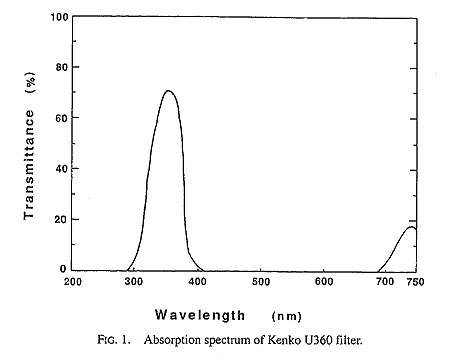
During the botanical expeditions to Nepal it was usually rainy or cloudy every day because of the rainy season. The photos were taken mostly in soft sunlight, and photos taken in strong sunlight were few.
Results and Discussion
The following is the list of 21 taxa examined in Nepal with sampling sites (altitude) and dates of the UV photos. The voucher specimens for the UV photos are cited after the date (Plates 2-9). All voucher specimens are deposited in the Herbarium of the Department of Botany, University Museum, University of Tokyo (TI).

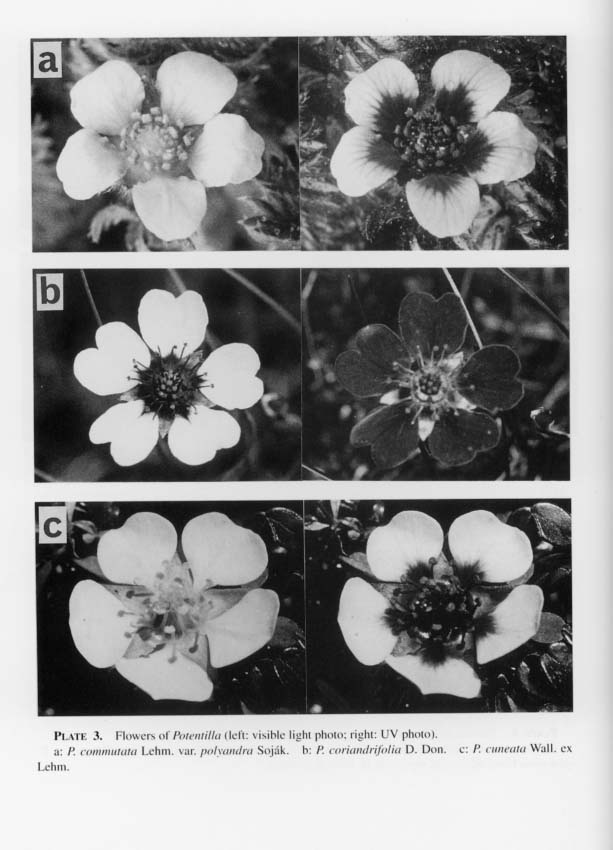
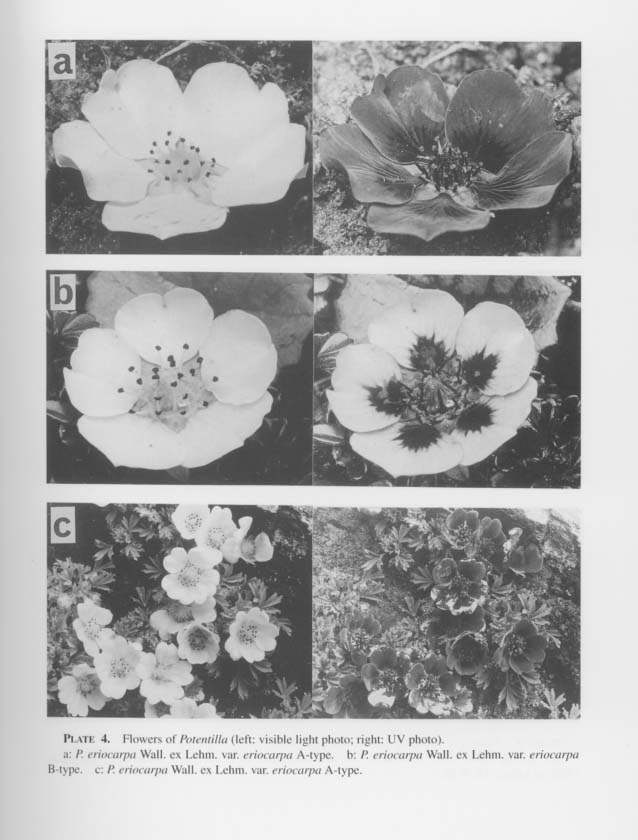
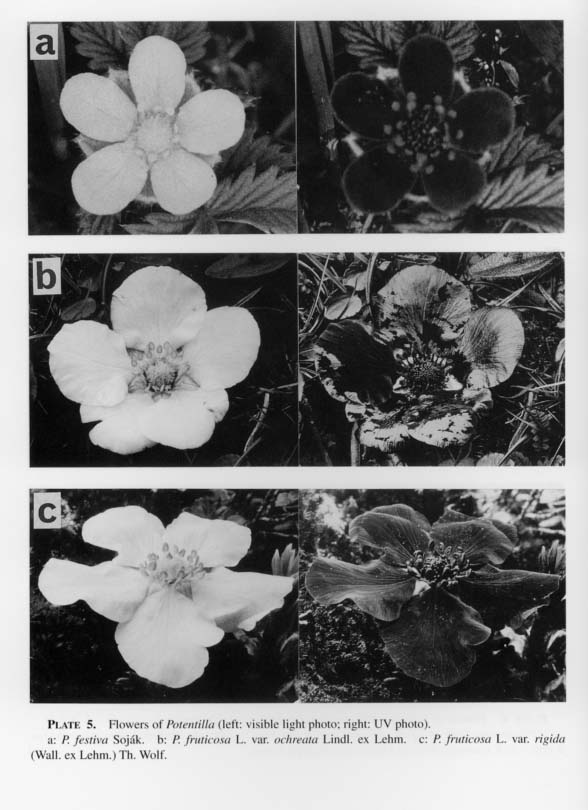
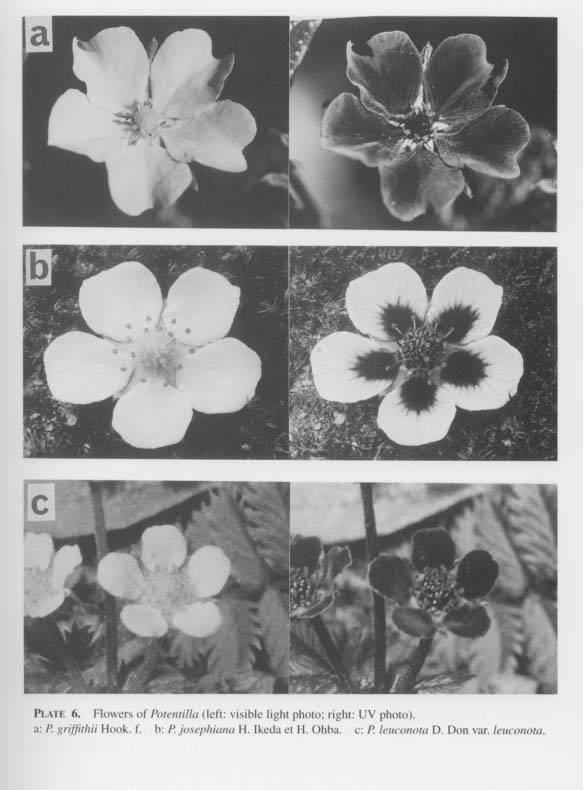
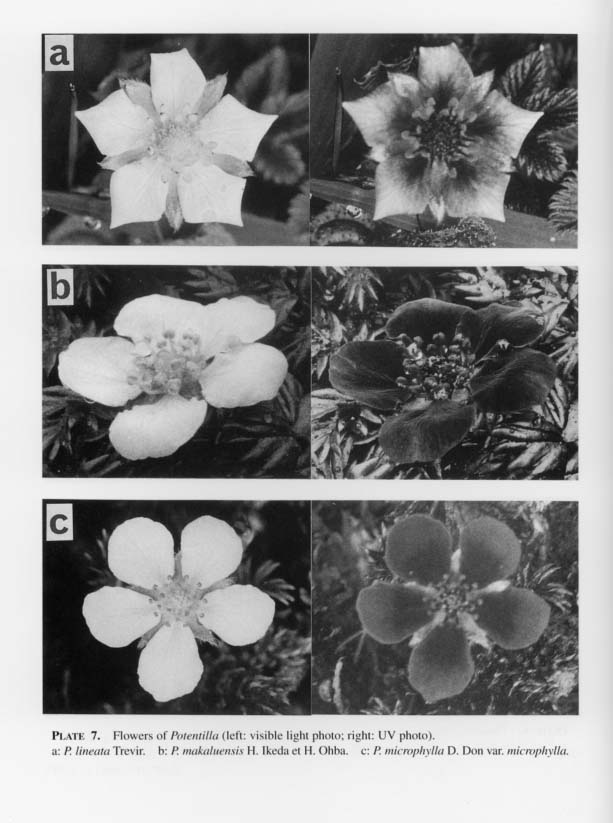
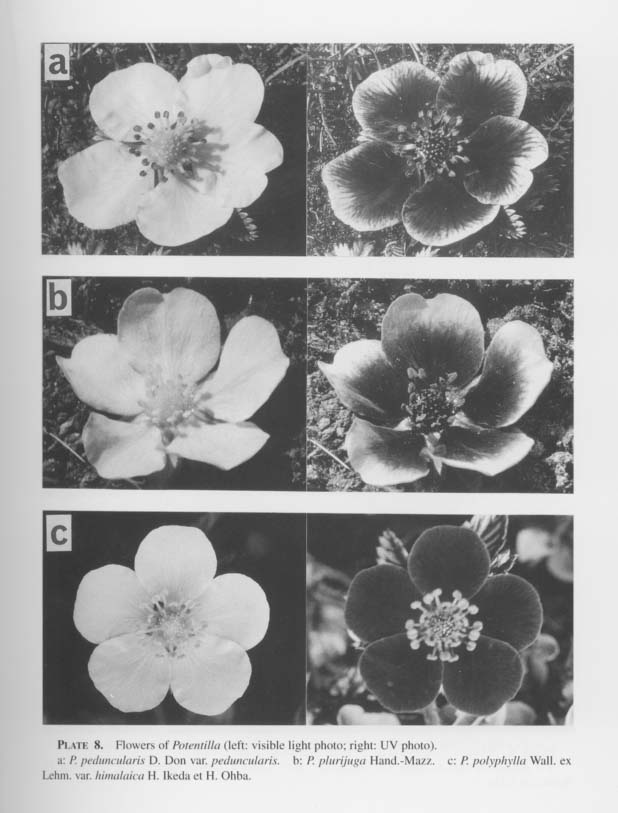

1. P. argyrophylla Wall. ex Lehm, agg. A-type
Cultivation in Toyama, Japan (50 m), May 16, 1991. Seed from Yak Kharka. P. argyrophylla Wall. ex Lebm. agg. B-type
Koshi Zone: Sankhuwa Sabha Distr., Merek (4450 m), Jul. 22, 1988; Shersing Kharka (4470 m), Jul. 26, 1988, v.s.n. 8810613 (voucher specimen number: M. Suzuki, N. Naruhashi, S. Kurosaki, Y. Kadota, M.N. Subedi, M. Minaki, S. Noshiro, H. Ikedano. 8810613).
2. P. cardotiana Hand.-Mazz. var. nepalensis H. Ikeda et H. Ohba
Koshi Zone: Sankhuwa Sabha Distr., Tutu La (4000 m), Jul. 30, 1988, v.s.n. 8810649.
3. P. commutata Lehm. var. polyandra Soják
Koshi Zone; Sankhuwa Sabha Distr., Shipton Pass (4000 m), Jul. 17, 1988, v.s.n. 8810437.
4. P. coriandrifolia D. Don
Koshi Zone: Sankhuwa Sabha Distr., Shipton Pass (4000 m), Jul. 17, 1988, v.s.n. 8810435; ibid. (4080 m), Jul. 30, 1988, v.s.n. 8810662; Jaljale Himal, around Banduke (4200 m), Jul. 26, 1991, v.s.n. 9130103.
5. P. cuneata Wall. ex Lehm.
Koshi Zone: Sankhuwa Sabha Distr., Khongma (3400 m), Jul. 18, 1988, v.s.n. 8810462; Ne Kharka (3700 m), Jul. 28, 1988, Jaljale Himal, Bomrang - Singoa Kharka (4200 m), Aug. 10,1991, v.s.n. 9130344. Daulagiri Zone: Mustang Distr., Yak Kharka (4210 m), Aug. 31, 1988.
6. P. eriocarpa Wall. ex Lehm. var. eriocarpa A-type
Koshi Zone: Sankhuwa Sabha Distr., Makalu Base Camp (4710 m), Jul. 25, 1988, v.s.n. 8810725; Ne Kharka (3780 m), Jul. 28, 1988, Jaljale Himal, Bomrang-Singoa Kharka (4630 m), Aug. 10, 1991, v.s.n. 9130341. Dhaulagiri Zone: Mustang Distr., Yak Kharka (4100 m), Aug. 31, 1988.
P.eriocarpa Wall. ex Lehm. var. eriocarpa B-type
Koshi Zone: Sankhuwa Sabha Distr., Ne Kharka (3720 m), Jul. 20, 1988, v.s.n. 8810508; Jaljale Himal, Bomrang - Singoa Kharka (4200m), Aug. 10, 1991, v.s.n. 9130339.
7. P.festiva Soják
Koshi Zone: Sankhuwa Sabha Distr., Kuwapani (1900 m), Jul. 9, 1988, v.s.n. 8810264; Milke Danda, Gupha Pokhari - Angare Kharka (2900 m), Jul. 17, 1991, v.s.n. 9132057; Dhankuta Distr., Tute-Tinjure Phedi (2385 m), Jul. 14, 1991, v.s.n. 9132025. Dhaulagiri Zone; Myagdi Distr., Shika (1900 m), Sept. 5, 1988. Bagmati Zone: Kathmandu Distr., Borlang Bhanjyng (2220 m), Sept. 14, 1988. Cultivation in Toyama, Japan (50 m), Jul. 29, 1991. Seed from Borlang Bhanjyng.
8. P.fruticosa L. var. ochreata Lindl. ex Lehm.
Dhaulagiri Zone: Mustang Distr., Yak Kharka (4210 m), Aug. 31, 1988, v.s.n. 8811218 & 8811240.
9. P.fruticosa L. var. rigida (Wall. ex Lehm.) Th. Wolf
Koshi Zone: Sankhuwa Sabha Distr., Ne Kharka (3720 m), Jul. 20, 1988, v.s.n. 8810506; Merek (4330m), Jul. 21, 1988, Milke Danda, Chhippon - Gidde (3465 m), Jul. 19, 1991, v.s.n. 9130065.
10. P. griffithii Hook. f.
Dhaulagiri Zone: Mustang Distr., Kabre (1880 m), Aug. 28, 1988, v.s.n. 8811146; Kalopani (2500 m), Sep. 2, 1988. Cultivation in Toyama, Japan (50 m), Oct. 3, 1991. Seed from Kalopani.
11. P. josephiana H. Ikeda et H. Ohba
Koshi Zone: Sankhuwa Sabha Distr., Thulo Pokhari (3980 m), Jul. 30, 1988, v.s.n. 8810657; Milke Danda, Gidde-Khokling (3300 m), Jul. 20, 1991, v.s.n. 9130071.
12. P. leuconota D. Don var. leuconota
Koshi Zone: Sankhuwa Sabha Distr., around Yangri Kharka (3540 m), Jul. 19, 1988, v.s.n. 8810423.
13. P. lineata Trevir.
Koshi Zone: Sankhuwa Sabha Distr., Sakrate (1800 m), Aug. 3, 1988; Dhankuta Distr., Tute-Tinjure Phedi (2385 m), Jul. 14, 1991, v.s.n. 9131025.
14. P. makaluensis H. Ikeda et H. Ohba
Koshi Zone: Sankhuwa Sabha Distr., Shipton Pass (4060 m), Jul. 30, 1988, v.s.n. 8810668.
15. P. microphylla D. Don var. microphylla
Koshi Zone: Sankhuwa Sabha Distr., Jak Kharka (4310 m), Jul. 21, 1988; Jaljale Himal, around Banduke (4200 m), Jul. 26, 1991, v.s.n. 9130107.
16. P. peduncularls D. Don var. peduncularis
Koshi Zone: Sankhuwa Sabha Distr., Cha Ding Kharka (3930 m), Jul. 30, 1988, v.s.n. 8810659; Jaljale Himal, around Banduke (4200 m), Jul. 26, 1991, v.s.n. 9130094.
17. P. plurijuga Hand.-Mazz.
Dhaulagiri Zone: Mustang Distr., Alubari (3600 m), Sept. 1, 1988, v.s.n. 8811257.
18. P. polyphylla Wall. ex Lehm. var. himalaica H. Ikeda et H. Ohba
Koshi Zone: Sankhuwa Sabha Distr., Jaljale Himal, Khokling Jaljale (3685 m),
Jul.21, 1991, v.s.n. 9130075.
19. P. polyphylla Wall. ex Lehm. var. polyphylla
Koshi Zone: Dhankuta Distr., Tute-Tinjure Phedi (2480 m), Jul. 14, 1991; v.s.n. 9133025; Sankhuwa Sabha Distr., Milke Danda, Gupha Pokhari - Angare Kharka (2900 m), Jul. 17, 1991, v.s.n. 9133057.
20. P. sundaica (Blume) Kuntze
Koshi Zone: Dhankuta Distr., Pakharibas (1659 m), Jul. 2, 1988, v.s.n. 8810054; Sankhuwa Sabha Distr., Sakurate (1800 m), Jul. 9, 1988, v.s.n. 8810241. Gandaki Zone: Kaski Distr., Banthanti (2530 m), Aug. 24, 1988. Dhulagiri Zone; Myadgi Distr., Phalante (2170 m), Sept. 5, 1988.
21. P. turfosoides H. Ikeda et H. Ohba
Koshi Zone: Sankhuwa Sabha Distr., Cha Ding Kharka (4060 m), Jul. 30, 1988, v.s.n. 8810655.
Photos of 21 taxa are presented in plates 2-9; their spectral properties are shown in Table 1. Within the 21 taxa, 19 taxa (P. argyrophylla agg., P. cardotiana var. nepalensis, P. commutata var. polyandra, P. coriandrifolia, P. eriocarpa var, eriocarpa, P. festiva, P. griffithii, P. josephiana, P. leuconota var. leuconota, P. lineata, P. makaluensis, P. microphylla var. microphylla, P. peduncularis var. pedunclaris, P. plurijuga, P. polyphylla vars. polyphylla and himalaica, P. sundaica and P. turfosoides) were examined for the first time.
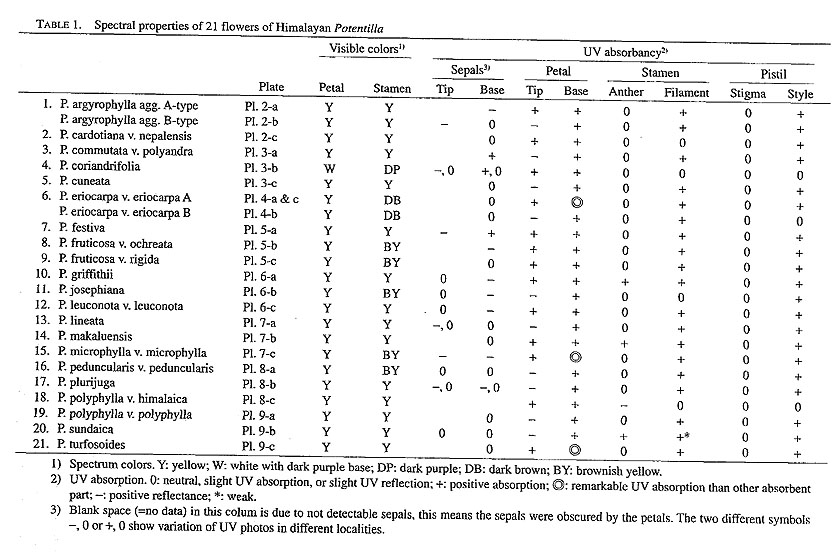
The visible color of the petals is yellow in all species except. P. coriandrifolia, which has white petals with dark purple at the base. In contrast, the UV patterning of the petals varied and the patterns can be categorized into three types based on UV absorption and reflection properties of the petals: 1) inner absorbing and outer reflecting type (type 1); 2) wholly absorbing without strong absorbing part (type 2); 3) wholly absorbing with strong absorption at base (type 3). Flowers of the type 1 varied from having a small basal absorbing spot (e.g., P. cuneata. Plate 3-c) to larger markings (e.g., P. peduncularis var. pedunclaris. Plate 8-a).
Pistils and stamens were UV absorbing in most taxa, and the sepals showed considerable variation as in the petals.
UV patterning in flowers of two species (P. fruticosa and P. cuneata) were reported by Daumer (1958) and Harbome and Nash (1984) and their reports are consistent with the senior author's preliminary observations (Naruhashi, unpublished) and the results of this study in the Nepal Himalaya.
Each of the five petals of a Potentilla flower rarely differed from each other in uniformity of UV absorption (e.g., Plates 2-c, 4-a, 4-c & 5-b), although they were almost the same shape and color under visible light. The flowers in Plate 4-c illustrate the lack of uniformity of UV patterning expressed within a single population of P. eriocarpa var. eriocarpa, which allegedly reproduces vegetatively. Such expression has never been reported before now, and it may be possible to comprehend such a phenomenon by assuming either an uneven, accumulation of chemical compounds or the decomposition of them caused by the severe environment in high mountains during development of the flower buds.
known (Naruhashi & Iwatsubo, 1991; Naruhashi, unpublished). Variation is exhibited not in quality, but in quantity, i.e., variation is represented by differences in the amount of UV absorption of reflection of floral parts. Variation in UV patterning within a species of Himalayan Potentilla was also observed. Potentilla argyrophylla agg. and P. eriocarpa var. eriocarpa showed two remarkably different types of UV patterning. Potentilla argyrophylla agg. showed a remarkable difference: strong UV absorption over the whole petal (Plate 2-a) and UV reflection with strong absorption at the base of the petal (Plate 2-b). Plants showing the latter pattern are similar to the Japanese and Canadian P. nivea. Plate 2-b of P. argyrophylla agg. is very similar to UV photos of Japanese and Canadian P. nivea. And P. argyrophylla and P. nivea are very similar in habit (whole plant, leaves, stems, inflorescence) and even flowers. But these both species are not taxonomically an intimate group, namely P. argyrophylla does not belong to P. nivea group of Soják (1989). (But, I think these do belong to the same group). Plate 2-a is also P. argyrophylla, morphologically. But the UV photo is very different from the UV photos of Japanese and Canadian P. nivea. The morphological differences between P. argyrophylla and P. nivea are difficult to observe. These two taxa need further investigation to determine their taxonomic status, although for now they are tentatively identified as P. argyrophylla agg.
In Potentilla eriocarpa var. eriocarpa, the A-type showed UV absorption by the whole petal (Plate 4-a); the B-type showed UV reflection except at the base of the petal (Plate 4-b), although both types had nectar guides. The two types also show a difference in outer morphological features. Plants of the A-type are smaller overall with linear leaf lobes and a cushion habit. B-type plants are larger with broader leaf lobes and are not cushion plants but instead have long rhizomes. The two plants may represent two different taxa based on their UV patterning and outer gross morphology, but they need further detailed study.
It can be concluded that Himalayan Potentilla do not express any remarkable char- acteristics in UY patterning in comparison with Potentilla from Japanese or other countries. However, UV patterning in P. festiva (Plate 5-a), which reflects UV at the tip of the sepals, and in P. polyphylla var. himalaica (Plate 8-c), which reflects from the anthers have not been reported previously and they are thought to be very interesting. UV reflection by the anthers is exceptional in Potentilla.
The relationship between UV patterning and taxonomic relationships and ecological conditions, such as habit, altitude, etc., is obscure. Only a small amount of research on UV patterning has been carried out and much more is needed before clear trends can be determined, since Potentilla, with about 500 species (Airy Shaw, 1973), is such a large genus.
Acknowledgments
It is a great pleasure to express our sincere gratitude to Dr. Mitsuo Suzuki (leader of the Jun. 23-Sept. 25, 1988, expedition), Dr. Hideaki Ohba (leader of the Jun. 30- Sept. 1, 1991, expedition) and other members of the Nepal-Japan Botanical Expedition. We thank Drs. David E. Boufford and Madjit Hakki for critical reading the manuscript. This research was supported by Grants-in Aid for Overseas Scientific Research, No. 62480014 (1988, to M. S.) and No. 03041029 (1991, to H. O.) from the Ministry of Education, Sciences, Sports and Culture, Japan.
References
- Airy Shaw, H. K. 1973.
- J. C. Willis's Dictionary of the Flowering Plants and Ferns. 8th ed., p. 940. Cambridge University Press, Cambridge.
- Barth, F. G. 1985.
- Insect and Flowers. 297 pp. Princeton University Press, Princeton, New Jersey.
- Daumer, K. 1958.
- Blumenfarben, wie sie die Bienen sehen. Z. vergl. Physiol. 41: 49-110.
- Eisner, T., R. E. Silberglied, D. Aneshansley, J. E. Carvel and H. C. Rowland. 1969.
- Ultraviolet video-viewing: the television camera as an insect eye. Science 166: 1172-1174.
- Harborne, J. B. and R. J. Nash. 1984.
- Flavonoid pigments responsible for ultraviolet patterning in petals of the genus Potentilla. Biochem. Syst. Ecol. 12: 315-318.
- Kevan, P. G. 1972.
- Floral colors in the high arctic with reference to insect-flower relations and pollination. Can. J. Bot. 50: 2289-2316.
- Kugler, H. 1963.
- UV-Musterungen auf Blüten und ihr zustandekommen. Planta 59: 296-329.
- ———. 1966.
- UV-Male auf Blüten. Ber. Dtsch. Bot. Ges. 79: 57-70.
- Lotmar, R. 1933.
- Neue Untersuchungen über den Farbensinn der Bienen. mit besonderer Berucksichtigung des Ultravioletts. Z. vergl. Physiol. 19: 673-723.
- Lutz, F. E. 1924.
- Apparently non-selective characters and combinations of characters, including a study of ultraviolet in relation to the flower-visiting habits of insect. Annals N. Y. Acad. Sci.29: 181-283.
- Mazochin-Porshnyakov, G. A. 1959.
- Ultraviolet reflection of flowers and the vision of insects. Entomol. Obozr. 38: 312-325.
- Mulligan, G. A. and P. G. Kevan. 1973.
- Color, brighteness, and other floral characteristics attracting insects to the blossoms of some Canadian weeds. Can. J. Bot. 51: 1939-1952. 29: 29-31.
- Naruhashi, N. 1981.
- A new hybrid of Potentilla (Rosaceae). J. Phytogeogr. Taxon.
- ——— and Y. Iwatsubo. 1991.
- Comparative morphology of flowers and chromosome numbers in Duchesnea indica (Rosaceae) from Nepal and Japan. In: Ohba. H. and S. B. Malla (ed.), The Himalayan Plants. Vol. 2, pp. 11-15, Pls. 1-4. University of Tokyo Press, Tokyo.
- Richtmyer, F. K. 1923.
- The reflection of ultraviolet by flowers. J. opt. Soc. Amer. 7: 151-168.
- Soják, J. 1989.
- Notes on Potentilla (Rosaceae) VIII. P. nivea L. agg. Candollea 44: 741-762.
- Tweedie, M. 1971.
- Insects & ultraviolet, a new look. Animals 13: 760-762.
- Ultech, F.H. and S. Kawano. 1975.
- Spectral polymorphisms in angiosperms flowers determined by differential ultraviolet reflectance. Bot. Mag. Tokyo 88: 9-30.
- Ziegenspeck, H. 1955.
- Die Farben- und UV-photographie und ihre Bedeutung für die Blütenbiologie. Mikroskopie 10: 323-328.









